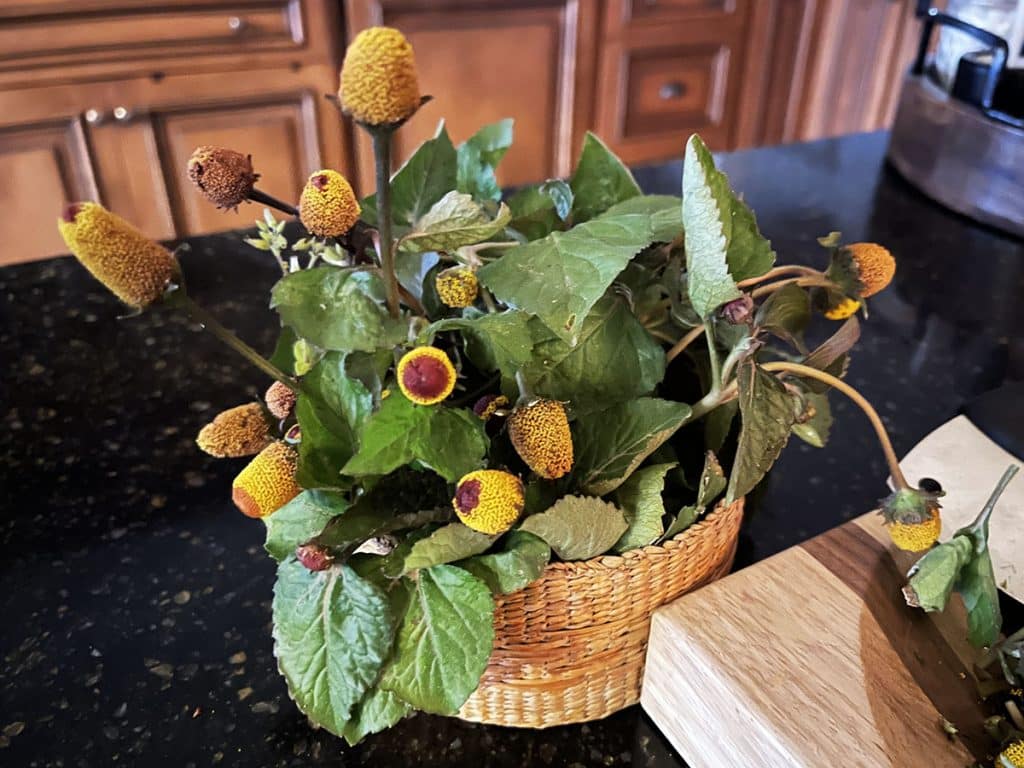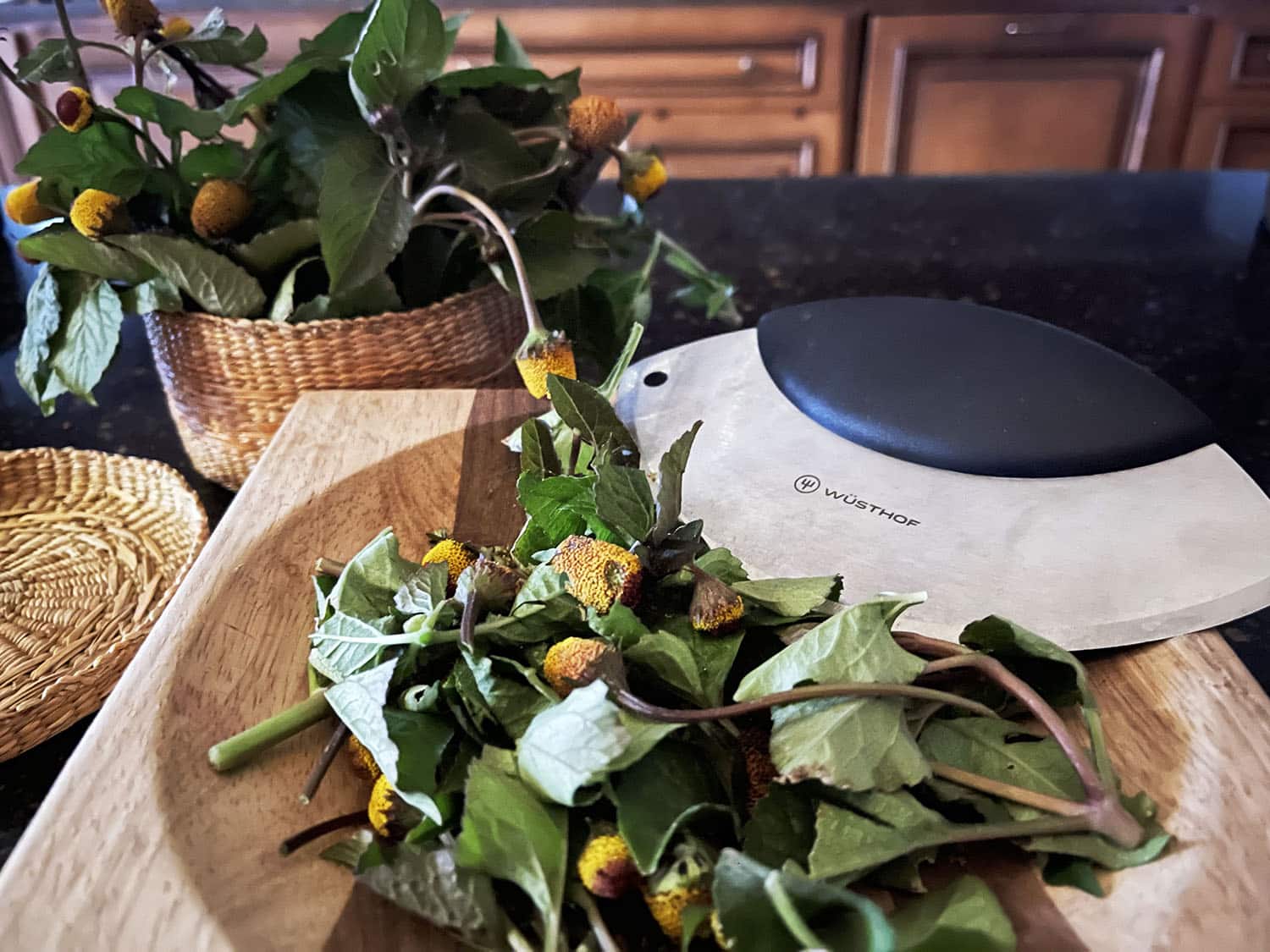At a recent herbal apprenticeship class, I was introduced to Acmella oleracea, also known as spilanthes, buzz buttons or the “toothache plant.”
Spilanthes is a frost-tender tropical plant and not remotely native to northern climates, but it can be grown as an annual in most growing zones given enough sun and water. With unusual looking yellow and red gumdrop-shaped flower heads, spilanthes can be a visually striking addition to a flower or herb garden.
Bumble bee butts
Our instructor Suzanne has a lovely, large cultivated patch in her home medicine garden. By way of an introduction, we were instructed to take a nibble off the end of a flower (“for heaven’s sake, don’t eat the whole thing,” she said) and note the taste and sensation.
The first thing you notice is a sour and slightly bitter flavor, followed by an odd tingling sensation that quickly intensifies into numbness throughout your mouth… trippy!!
Upon tasting splinathes for the first time, one of the apprentices commented, “It… feels like… bumble bees… in my mouth!” She now refers to them as “bumble bee butts.”

Toothache plant
Spilanthes is a South American native of the Asteraceae family that’s been used in traditional medicine for centuries, particularly in Ayurveda and TCM.
Because of its similarities to the medicinal actions of echinacea as an immunostimulant (immunity booster), anti-inflammatory, antiviral and antimicrobial, Suzanne suggests a combination elderberry and spilanthes for preparations geared toward cold and flu season, particularly for ailments of the respiratory system.
Spilanthes is also a handy remedy for any kind of oral discomfort (hence its name “toothache plant”), including dry mouth, canker sores and pain following dental work such as root canals. It’s both an oral antiseptic and a numbing anaesthetic that can be used as a gargle to soothe and inflamed sore throat.
The aerial parts (leaves, flower, stem) of spilanthes contain alkylamides that are responsible for its distinctive pungent taste and tingling/numbing sensation when chewed — specifically, spilanthol, which is the most abundant alkylamide found in spilanthes. It is believed that spilanthol works by activating the body’s endocannabinoid system, which is involved in regulating pain, inflammation and immune function.
As a topical for bacterial skin infections, spilanthes has shown potential as a powerful antimicrobial capable of controlling even antibiotic resistant strains.
An herbal… botox alternative?
Surprisingly, spilanthes may also have potential as an anti-aging (ahem, healthy aging) agent, thanks to studies suggesting that it accelerates collagen synthesis. One study found that in combination with gotu kola, ginger and ferulic acid, spilanthes can stimulate the synthesis of type-I collagen in fibroblasts while decreasing the degradation of existing collagen.
While researching spilanthes for my monograph, I stumbled across a few products featuring spilanthol — the source of spilanthes’ anaesthetic and insecticide properties — both marketed as a natural and noninvasive alternative to botox.
Interesting stuff.
I’d say this has “future formulating experiment” written all over it, doesn’t it?

Tincture of spilanthes
I settled on an alcohol tincture as the most versatile way to preserve my fresh splilanthes. A tincture can be drop-dosed in water to make a tea, diluted as a topical compress or gargle… or used as an additive to the water phase of a future skincare product. (woot! woot!)
In Making Plant Medicine, Richo Cech recommends a splilanthes tincture made of 1 part herb by weight to 2 parts (100%) alcohol by volume.
As usual, I did not weigh or measure, but simply chopped up my spilanthes to expose as much surface area as I could, and filled a pint jar. Then I filled it to the top with 190 proof grain alcohol.
(For our purposes, we’re going to ignore the 5% water and pretend that 190 proof is 100% alcohol. 190 proof is easier to come by and I really don’t believe it will make a huge difference to the final product.)
Allow the tincture to macerate for 2 to 3 weeks before pressing and straining out the spent spilanthes.

Pro tip for herb chopping
P.S. If you process a lot of herbs — whether culinary or medicinal — an investment in a mezzaluna or “ulu” style rocker knife set is worth every penny. They really do make chopping/mincing large amounts of herbs, garlic, onion, etc. so much easier and faster and FUN!
At the beginning of my apprenticeship, one student had an Alaskan ulu set. 5 months later, all of us have our own — including the teacher.
…
Have you grown or worked with spilanthes before? Let us know in the comments!



